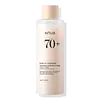What's inside
What's inside
 Key Ingredients
Key Ingredients

 Benefits
Benefits

 Concerns
Concerns

No concerns
 Ingredients Side-by-side
Ingredients Side-by-side

Oryza Sativa Bran Water 71%
MaskingButylene Glycol
HumectantGlycerin
HumectantDipropylene Glycol
HumectantNiacinamide
SmoothingPropanediol
SolventWater
Skin Conditioning1,2-Hexanediol
Skin ConditioningMethyl Gluceth-20
HumectantPanthenol
Skin ConditioningBetaine
HumectantOryza Sativa Extract
AbsorbentHydroxyacetophenone
AntioxidantDiphenyl Dimethicone
EmollientTriethylhexanoin
MaskingHydrogenated Lecithin
EmulsifyingAdenosine
Skin ConditioningEthylhexylglycerin
Skin ConditioningCarbomer
Emulsion StabilisingTromethamine
BufferingXanthan Gum
EmulsifyingGlyceryl Acrylate/Acrylic Acid Copolymer
HumectantTheobroma Cacao Seed Extract
AntioxidantSodium Hyaluronate
HumectantHydrolyzed Hyaluronic Acid
HumectantHyaluronic Acid
HumectantDextrin
AbsorbentHydrolyzed Rice Protein
Skin ConditioningOryza Sativa Seed Protein
AntioxidantCeramide NP
Skin ConditioningSodium Lauroyl Lactylate
EmulsifyingArbutin
AntioxidantAscorbic Acid
AntioxidantAllantoin
Skin ConditioningCeramide AP
Skin ConditioningPhytosphingosine
Skin ConditioningCholesterol
EmollientCeramide EOP
Skin ConditioningOryza Sativa Bran Water 71%, Butylene Glycol, Glycerin, Dipropylene Glycol, Niacinamide, Propanediol, Water, 1,2-Hexanediol, Methyl Gluceth-20, Panthenol, Betaine, Oryza Sativa Extract, Hydroxyacetophenone, Diphenyl Dimethicone, Triethylhexanoin, Hydrogenated Lecithin, Adenosine, Ethylhexylglycerin, Carbomer, Tromethamine, Xanthan Gum, Glyceryl Acrylate/Acrylic Acid Copolymer, Theobroma Cacao Seed Extract, Sodium Hyaluronate, Hydrolyzed Hyaluronic Acid, Hyaluronic Acid, Dextrin, Hydrolyzed Rice Protein, Oryza Sativa Seed Protein, Ceramide NP, Sodium Lauroyl Lactylate, Arbutin, Ascorbic Acid, Allantoin, Ceramide AP, Phytosphingosine, Cholesterol, Ceramide EOP
Water
Skin ConditioningAlcohol
AntimicrobialButylene Glycol
HumectantGlycerin
HumectantPropylene Glycol
HumectantHamamelis Virginiana Water
AstringentSodium Hyaluronate
HumectantAloe Barbadensis Leaf Extract
EmollientHexylene Glycol
EmulsifyingFructose
HumectantGlucose
HumectantSucrose
HumectantGlutamic Acid
HumectantAspartic Acid
MaskingHexyl Nicotinate
EmollientAlanine
MaskingDextrin
AbsorbentUrea
BufferingCoceth-7
EmulsifyingPPG-1-PEG-9 Lauryl Glycol Ether
EmulsifyingPEG-40 Hydrogenated Castor Oil
EmulsifyingSodium Citrate
BufferingDisodium EDTA
Benzoic Acid
MaskingPhenoxyethanol
PreservativeEthylhexylglycerin
Skin ConditioningCaprylyl Glycol
EmollientParfum
MaskingWater, Alcohol, Butylene Glycol, Glycerin, Propylene Glycol, Hamamelis Virginiana Water, Sodium Hyaluronate, Aloe Barbadensis Leaf Extract, Hexylene Glycol, Fructose, Glucose, Sucrose, Glutamic Acid, Aspartic Acid, Hexyl Nicotinate, Alanine, Dextrin, Urea, Coceth-7, PPG-1-PEG-9 Lauryl Glycol Ether, PEG-40 Hydrogenated Castor Oil, Sodium Citrate, Disodium EDTA, Benzoic Acid, Phenoxyethanol, Ethylhexylglycerin, Caprylyl Glycol, Parfum
 Reviews
Reviews

Ingredients Explained
These ingredients are found in both products.
Ingredients higher up in an ingredient list are typically present in a larger amount.
Butylene Glycol (or BG) is used within cosmetic products for a few different reasons:
Overall, Butylene Glycol is a safe and well-rounded ingredient that works well with other ingredients.
Though this ingredient works well with most skin types, some people with sensitive skin may experience a reaction such as allergic rashes, closed comedones, or itchiness.
Learn more about Butylene GlycolDextrin is used to thicken a product and helps bind ingredients together. It is created from starch and glycogen.
As an emulsifier, dextrin prevents ingredients from separating. This helps elongate a product's shelf life.
Studies show coating UV filters with dextrin prevents these ingredients from being absorbed. This helps UV ingredients last longer on the skin.
Learn more about DextrinEthylhexylglycerin (we can't pronounce this either) is commonly used as a preservative and skin softener. It is derived from glyceryl.
You might see Ethylhexylglycerin often paired with other preservatives such as phenoxyethanol. Ethylhexylglycerin has been found to increase the effectiveness of these other preservatives.
Glycerin is already naturally found in your skin. It helps moisturize and protect your skin.
A study from 2016 found glycerin to be more effective as a humectant than AHAs and hyaluronic acid.
As a humectant, it helps the skin stay hydrated by pulling moisture to your skin. The low molecular weight of glycerin allows it to pull moisture into the deeper layers of your skin.
Hydrated skin improves your skin barrier; Your skin barrier helps protect against irritants and bacteria.
Glycerin has also been found to have antimicrobial and antiviral properties. Due to these properties, glycerin is often used in wound and burn treatments.
In cosmetics, glycerin is usually derived from plants such as soybean or palm. However, it can also be sourced from animals, such as tallow or animal fat.
This ingredient is organic, colorless, odorless, and non-toxic.
Glycerin is the name for this ingredient in American English. British English uses Glycerol/Glycerine.
Learn more about GlycerinSodium Hyaluronate is hyaluronic acid's salt form. It is commonly derived from the sodium salt of hyaluronic acid.
Like hyaluronic acid, it is great at holding water and acts as a humectant. This makes it a great skin hydrating ingredient.
Sodium Hyaluronate is naturally occurring in our bodies and is mostly found in eye fluid and joints.
These are some other common types of Hyaluronic Acid:
Learn more about Sodium HyaluronateWater. It's the most common cosmetic ingredient of all. You'll usually see it at the top of ingredient lists, meaning that it makes up the largest part of the product.
So why is it so popular? Water most often acts as a solvent - this means that it helps dissolve other ingredients into the formulation.
You'll also recognize water as that liquid we all need to stay alive. If you see this, drink a glass of water. Stay hydrated!
Learn more about Water